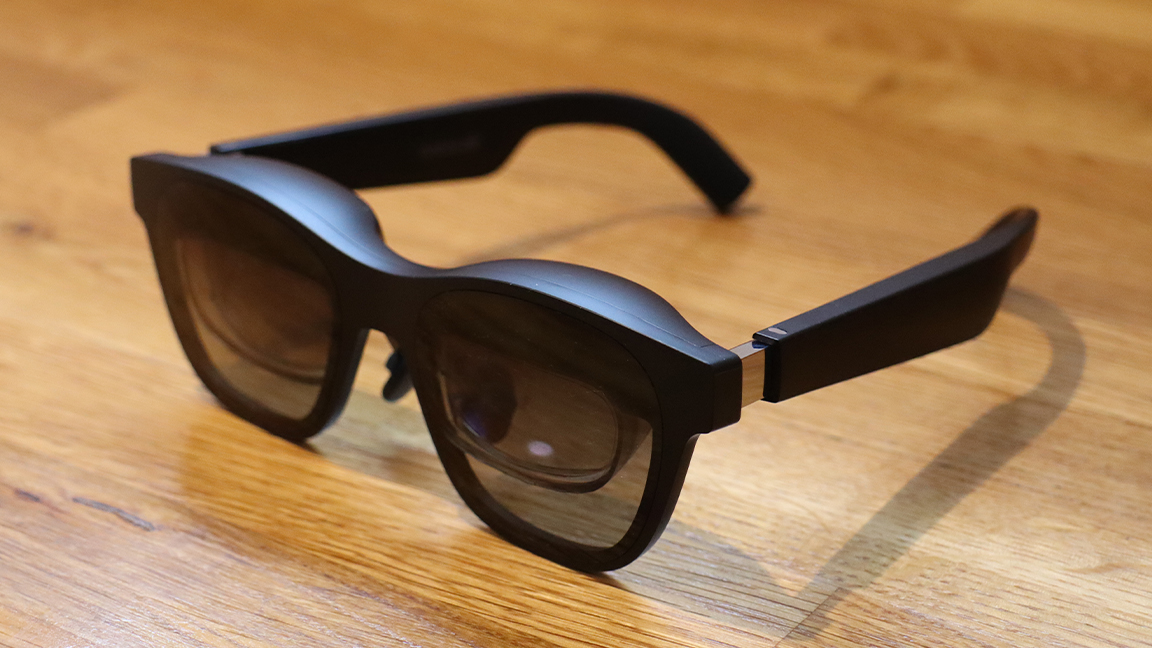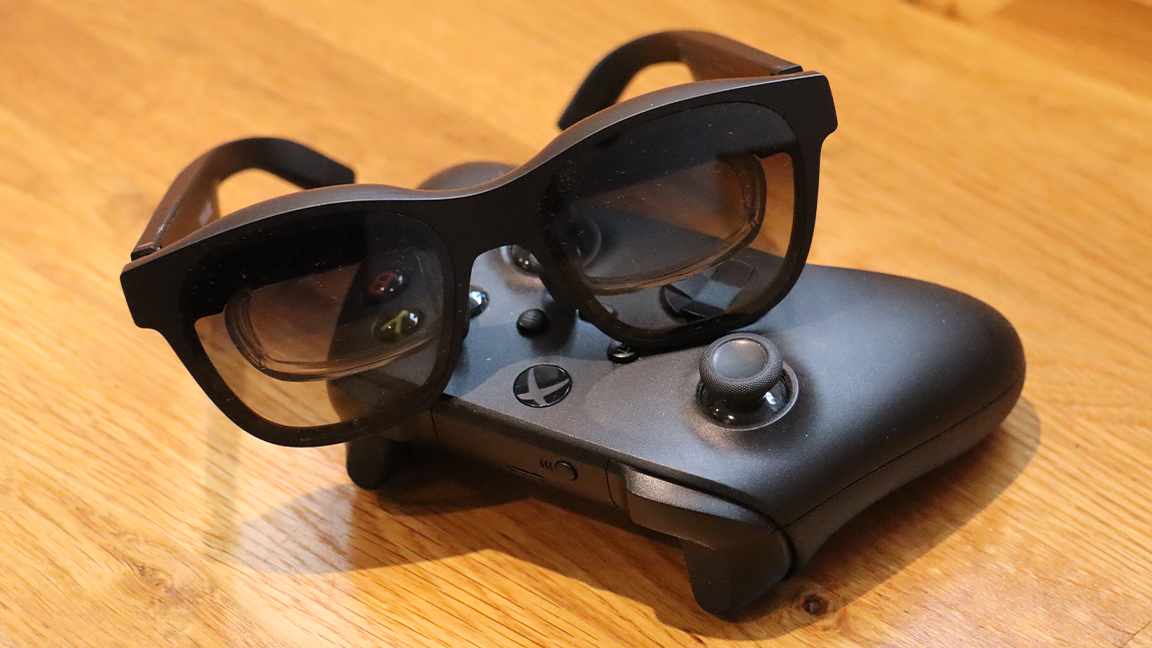
Nreal Air is the leading brand for AR glasses, but I've never really understood what they are for; heavier than standard sunglasses and lacking the full virtual worlds of VR, I've always looked at this technology dumbfounded. But recently I tried Nreal Air and to my surprise I finally got what all the fuss is about.
AR, or augmented reality, to give the tech its proper name, has had its champions for years. Many leading clever folks see full AR as the end result of VR; Microsoft for one has viewed virtual reality as a stepping stone to AR. But holding AR back has always been those muddled preconceptions, after all do you really want to view your phone all day and never escape the updates from Vloggers eager to sell you energy drinks?
AR glasses enable you to, technically, watch movies and play games on a personal 154-inch full HD display
This was me before I tried Nreal Air, before I had actually spent time making use of AR. Me AR 1.0, if you will. Now let's wind back a little. What is Nreal Air? These are arguably the first AR glasses to make the tech mainstream. The plug-and-go design and excellent image quality avoids the hangups of many other AR brands.
Using these AR glasses is as simple as plugging them into a compatible device and, ideally, downloading the Nebula app. You will need one of the latest iPhones or the best Android phones, such as the Samsung Galaxy S23 Ultra, if you're going mobile, but Nreal Air now also connects to Nintendo Switch, PlayStation 5 and Windows devices, such as Xbox Series X.
Once plugged in, your device's screen is projected in front of you via the AR glasses, enabling you to, technically, watch movies and play games on a personal 154-inch full HD display. It's like having your own IMAX all to yourself to experience movies and games, and updates from your friends bickering over the Spurs Everton result, like never before.
Nreal Air is AR, but a little different

Sounds great, so why was I, and many others, AR-averse? Despite a simple design that resembles a pair of Ray-Bans, the Nreal Air are a litter heavy and feel a bit cumbersome. Other brands are even heavier and not nearly as approachable. Some clever choices have been made with Nreal Air, such as inserting small speakers into the rear of the glasses' arms.
Design aside, I'd always been put off by AR glasses because of issues over privacy. Earlier devices such as Ray-Ban Stories and Google Glass had built-in cameras, which while fine as an idea, I never really felt comfortable with Google tracking what I'm looking at and vice versa – do passengers on my train really want to be broadcast?
Daily design news, reviews, how-tos and more, as picked by the editors.
My first test of Nreal Air was on that train, and well, I thought it would be more fun. I had visions of popping on the AR glasses, sitting back and watching Luther all the way into London. The reality was a little different; it turns out other people like to use public transport too, and between needing to move for the lady who wants the toilet, the attendant checking my ticket and the kid opposite intent on teaching me the lyrics to Mel Mad Me Do It, as it turns out, trains are busy. Nreal Air 0, real life 1.
AR is really a gaming device

My change of heart on AR glasses came when I settled down onto the sofa for a gaming marathon. As it turns out, AR is at its best when you're immersed in your worlds. As mentioned you can hook up Switch to the Nreal Air but a recent update to the Nebula app means you can now connect to PS5 and Xbox Series X. (You will need the Nreal Adapter).
Playing Horizon Forbidden West in AR is, actually, incredibly immersive. The glasses are 'see through', meaning the game's video is essentially projected between you and the real world. The Nreal Air comes with caps to place over the lenses so you can retreat to your own world.
The HD image quality is excellent and crisp and it has the feeling of playing a projected experience onto a wall rather than viewed on TV or monitor display. With AR size does matter too, and it feels like the game is larger than life. It's not VR, so PSVR 2 is safe and its cinematic mode is far more immersive and generally a better experience, but Nreal Air has its unique perks.
At the recent Game Developer's Conference (GDC) Nreal shared how it's Nreal Air glasses can simulate an ultrawide virtual monitor using an updated to the Nebula for Windows app. You can play Forza Horizon 5 in a virtual curved display, with an impressive 21:9 aspect ratio, though not on Xbox so you'll need a gaming PC.

It turns out I'm not alone in weeding out why AR can be useful. A study by Nreal shows 68% of those who own their AR glasses use them as a gaming peripheral, and 56%, like me, use the Nreal Air glasses for console gaming. Playstation and Xbox account for 14%, with Steam Deck owners keener at 36% – which is understandable if you want a larger screen for your mobile PC gaming.
It's clear Nreal sees the future of its AR glasses as an add-on for gaming
It's clear Nreal sees the future of its AR glasses as an add-on for gaming. The simple UI works neatly with games and the experience of playing inside the AR glasses is, actually, quite good. This isn't VR, so you don't have that same sense of isolation, but it's still one foot in your own world while maintaining awareness of your 'real life'.
Nreal Air is elbowing its way into the VR space with its inclusion of enhanced 3-DoF tracking (degrees of freedom). This tracks your head movement so its able to offer a virtual gaming cockpit so you feel inside the game and UI a little more. This isn't a match for PSVR 2's inside out tracking or 6 DoF, but for AR glasses it's kind of a big deal and Windows gamers it's a novel approach.
AR glasses aren't what I imagined. I figured Nreal Air would be my golden ticket to silo myself away on a long commute. The reality is AR glasses are a great way to play video games, whether on the couch or on the go. Sure, it feels like a gateway to more expensive VR, or the building blocks of more complex AR and Web 3 innovations, but I finally see how AR could be a leap ahead, if and when the technology. It's game on for AR.
Read more:
- VR and AR could be the future of UX design
- PSVR 2: everything you need to know
- 8 golden rules for AR design

Ian Dean is Editor, Digital Arts & 3D at Creative Bloq, and the former editor of many leading magazines. These titles included ImagineFX, 3D World and video game titles Play and Official PlayStation Magazine. Ian launched Xbox magazine X360 and edited PlayStation World. For Creative Bloq, Ian combines his experiences to bring the latest news on digital art, VFX and video games and tech, and in his spare time he doodles in Procreate, ArtRage, and Rebelle while finding time to play Xbox and PS5.
